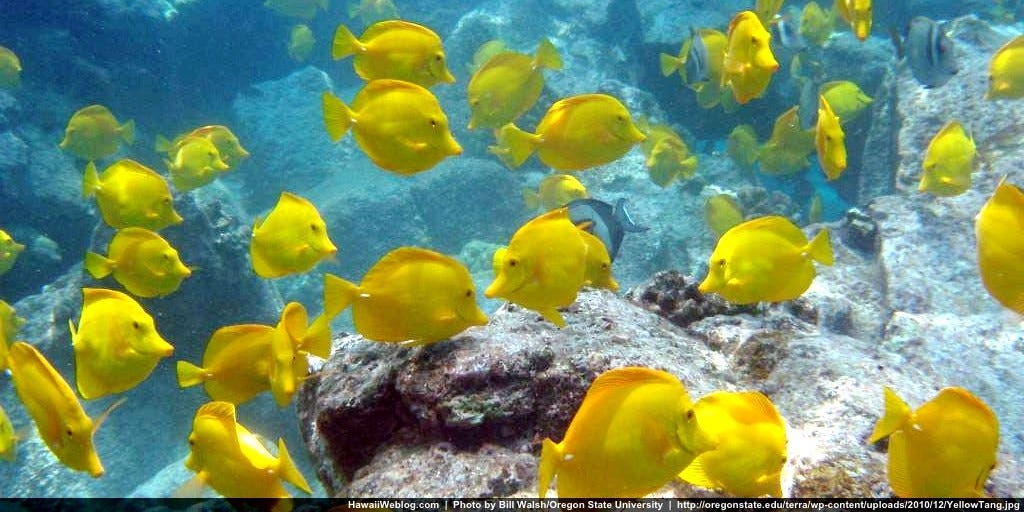Hawaii Researchers First to Raise Yellow Tang in Captivity

The Oceanic Institute announced last week that it was the first facility in the world to successfully breed and raise yellow tang. And the news about this little fish is a big deal for both the environment, as well as the aquarium trade.
The distinctive, brilliantly colored yellow tang (Zebrasoma flavescens) is one of the most popular fish among aquarium aficionados. But because, historically, they can only be found in the wild, they have been aggressively harvested from natural reefs.
These harvests threatens sensitive reef ecosystems, which is a big deal in Hawaii, where our reefs are said to be worth $34 billion a year to the state through recreation and conservation activities as well as food fishing. The practice has prompted policy battles over Hawaii waters. The yellow tang in particular makes up the vast majority (over 84 percent, according to the state Department of Land and Natural Resources) of local aquarium fishery harvests, with an estimated 300,000 of them captured and shipped around the world each year.
This captive breeding breakthrough came through the institute's Finfish Research program, which has worked for decades to preserve wild fish populations by increasing hatchery production of both aquarium and food fish species. Its list of successful species includes the Pacific threadfin, amberjack, red snapper, bluefin trevally, and flame angelfish.
But the progression also meant researchers were working with increasingly complex challenges, especially in dealing with smaller and smaller eggs, making it difficult to rear fish larvae. The Oceanic Institute has been working on the yellow tang for 15 years, redesigning broodstock holding tanks, developing dietary systems to increase egg quality and quantity, designing larval rearing tanks to help them survive their earliest feedings, helped along by specialized lighting and other equipment.
In 2013, the institute reported making significant progress, producing more than 1 million eggs a month -- 84 percent of them fertilized, and 51 percent of them ultimately viable. The institute -- which merged with Hawaii Pacific University last year -- received $75,000 in new funding for its yellow tang research in January, and announced in November that it had been able to keep captive reared yellow tang alive for 83 days.

Today, the Oceanic Institute has tanks that contain as many as 150 juvenile yellow tang, ranging in age from 70 to 90 days old.
"We are really excited to finally see the results of over a decade’s work coming to fruition," said the institute's finfish program director Chatham Callan in a statement. "We look forward to continuing this important work, aimed now at improving the methods necessary to take this to the next level."
"This recent achievement with yellow tang could be a game changer, and we are all looking forward to continuing this important work," said Oceanic Institute Executive Director Shaun Moss.
Institute officials note that while 95 percent of freshwater aquarium fish are raised in aquaculture, nearly 98 percent of marine aquarium species are wild caught. Not only can captive breeding programs feed that demand, but they can also help restore natural habitats.
"[These] achievements have implications and impacts far beyond those in the marine aquarium trade," Moss added. "Our ability to raise yellow tang in captivity now affords us the opportunity to enhance wild stocks with captive-reared fish as we did with moi and mullet in the past... In addition, we now have an invaluable research tool to explore the impacts a global climate change on larval development of important coral reef fish species."
For more information, visit OceanicInstitute.org, or connect with the institute on Facebook.
Photos courtesy Oceanic Institute/HPU and Oregon State University.











